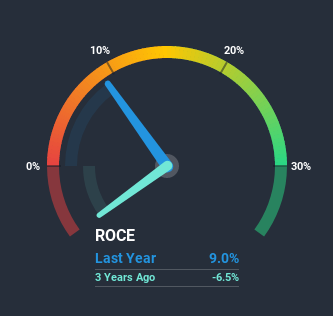Stock Analysis
- Taiwan
- /
- Electronic Equipment and Components
- /
- TWSE:8046
What Can The Trends At Nan Ya Printed Circuit Board (TPE:8046) Tell Us About Their Returns?

What are the early trends we should look for to identify a stock that could multiply in value over the long term? Typically, we'll want to notice a trend of growing return on capital employed (ROCE) and alongside that, an expanding base of capital employed. Put simply, these types of businesses are compounding machines, meaning they are continually reinvesting their earnings at ever-higher rates of return. Speaking of which, we noticed some great changes in Nan Ya Printed Circuit Board's (TPE:8046) returns on capital, so let's have a look.
Understanding Return On Capital Employed (ROCE)
If you haven't worked with ROCE before, it measures the 'return' (pre-tax profit) a company generates from capital employed in its business. Analysts use this formula to calculate it for Nan Ya Printed Circuit Board:
Return on Capital Employed = Earnings Before Interest and Tax (EBIT) ÷ (Total Assets - Current Liabilities)
0.09 = NT$3.1b ÷ (NT$41b - NT$6.8b) (Based on the trailing twelve months to September 2020).
Thus, Nan Ya Printed Circuit Board has an ROCE of 9.0%. In absolute terms, that's a low return but it's around the Electronic industry average of 11%.
See our latest analysis for Nan Ya Printed Circuit Board

Above you can see how the current ROCE for Nan Ya Printed Circuit Board compares to its prior returns on capital, but there's only so much you can tell from the past. If you'd like, you can check out the forecasts from the analysts covering Nan Ya Printed Circuit Board here for free.
The Trend Of ROCE
Nan Ya Printed Circuit Board has broken into the black (profitability) and we're sure it's a sight for sore eyes. The company now earns 9.0% on its capital, because five years ago it was incurring losses. On top of that, what's interesting is that the amount of capital being employed has remained steady, so the business hasn't needed to put any additional money to work to generate these higher returns. With no noticeable increase in capital employed, it's worth knowing what the company plans on doing going forward in regards to reinvesting and growing the business. After all, a company can only become a long term multi-bagger if it continually reinvests in itself at high rates of return.
Our Take On Nan Ya Printed Circuit Board's ROCE
In summary, we're delighted to see that Nan Ya Printed Circuit Board has been able to increase efficiencies and earn higher rates of return on the same amount of capital. And a remarkable 449% total return over the last five years tells us that investors are expecting more good things to come in the future. So given the stock has proven it has promising trends, it's worth researching the company further to see if these trends are likely to persist.
Since virtually every company faces some risks, it's worth knowing what they are, and we've spotted 2 warning signs for Nan Ya Printed Circuit Board (of which 1 is significant!) that you should know about.
For those who like to invest in solid companies, check out this free list of companies with solid balance sheets and high returns on equity.
If you’re looking to trade Nan Ya Printed Circuit Board, open an account with the lowest-cost* platform trusted by professionals, Interactive Brokers. Their clients from over 200 countries and territories trade stocks, options, futures, forex, bonds and funds worldwide from a single integrated account. Promoted
Valuation is complex, but we're helping make it simple.
Find out whether Nan Ya Printed Circuit Board is potentially over or undervalued by checking out our comprehensive analysis, which includes fair value estimates, risks and warnings, dividends, insider transactions and financial health.
View the Free AnalysisThis article by Simply Wall St is general in nature. It does not constitute a recommendation to buy or sell any stock, and does not take account of your objectives, or your financial situation. We aim to bring you long-term focused analysis driven by fundamental data. Note that our analysis may not factor in the latest price-sensitive company announcements or qualitative material. Simply Wall St has no position in any stocks mentioned.
*Interactive Brokers Rated Lowest Cost Broker by StockBrokers.com Annual Online Review 2020
Have feedback on this article? Concerned about the content? Get in touch with us directly. Alternatively, email editorial-team (at) simplywallst.com.
About TWSE:8046
Nan Ya Printed Circuit Board
Manufactures and sells printed circuit boards (PCBs) in Taiwan, the United States, Mainland China, Korea, and internationally.
Flawless balance sheet with reasonable growth potential.

